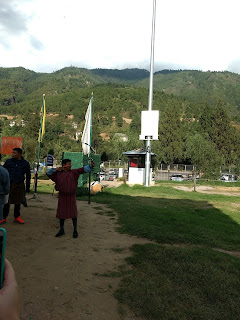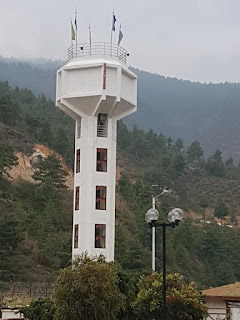Climbing to the Tiger's Nest was not quite as hard as I had anticipated. A few days prior we had make a short hike up to a temple and I was surprised at how winded I was getting, due to altitude I suppose. Additionally right after that we crossed a high pass on the way bay through Thimphu to Paro and I got a headache and dizziness. I was a bit afraid that as we climbed up to the Tiger's Nest that I would feel tired and sick again, but it didn't happen. Whether that was because it was a slow ascent or because by that point I was a bit more used to the height, I'm not sure.
We arrived at the base of the mountain at 8am and the forest was wrapped in a thick fog. There was not much you could see, but our guide pointed to some clouds and said, "its right there", which because a bit of a joke as we climbed. He said it would take us about 6 hours up and down, which I suppose was nearly right. We travelled in a group of three and I suppose if it were just Aya and me, or just me with the guide we could have moved a bit faster, but not by much.
On the first part of the trail there was a track for horses as well as people and some hikers chose to ride horses up the first 1/2 of the way. We decided to hike it. It took us about 2 hours to reach the place were the horses turned around (too steep) and there was a small tea house which, supposedly, had a nice view of the cliff grabbing temple, but all we could see was fog. After a short rest for tea and cookies we continued on. There was a bit of a hard part as once you get close enough to the temple you can see it straight across from you, but you have to go down a few hundred stairs and then back up again to actually get there. Perhaps the clouds were a bit lucky for us though as at least it wasn't too hot. Upon arriving at the temple we had to wait for our guide to catch up and take our bags and things to a small hut to check them in. No food, water, etc, inside the temple.
We entered together, and saw a few rooms were monks were praying as well as some very nice views of the valley. The most intense part was the room containing the Padmasambhava statue. Here were a dozen monks, blowing loudly on horns, chanting, and banging symbols. Quite the display. It was a unique temple and there were lots of monks there, but also lots of tourists. Despite starting early many of the other tourists had caught up to us, by foot or horse. Or so we thought. On the way down we realized that there were even more on the way up! the temple itself was built around a place where a monk from Indian had meditated for three years, three months, three days, and... yes, three hours in a cave on the mountain. At one place in the temple you can enter the area where he stayed and see how he got water from the rocks in the cave. Oh, and did I mention he flew there on a tiger? That is how the place gets it's name.
The way down was a bit easier and the sun had begun to burn off most of the morning fog, so the way down we had some better views of both the valley and the temple on the mountain.
Tashi comes off the mountain
After getting off the mountain we headed to lunch and then, wearily, to our hotel to rest a bit before the last treat of the day, a hot stone bath. That was something else and well worth the effort to go to the farmer's house to jump in. Tashi and Choki had told of these baths and, Aya being Aya, she of course had already researched this. Apparently Japanese people quite enjoy taking the baths.
At the farmer's house we took our bath, from hot stones take from the river and then placed in a fire, ultimately put into a tub to make the water warm. After the end of the bath we went inside the farmer's house for a nice home cooked dinner. This, of course, included the pepper cheese mix and many assorted veggie dishes, rice, and to my delight some ara, a rice alcohol similar to sake'. The meal, the company, and the bath were all an excellent way to end our last day in Bhutan.













































